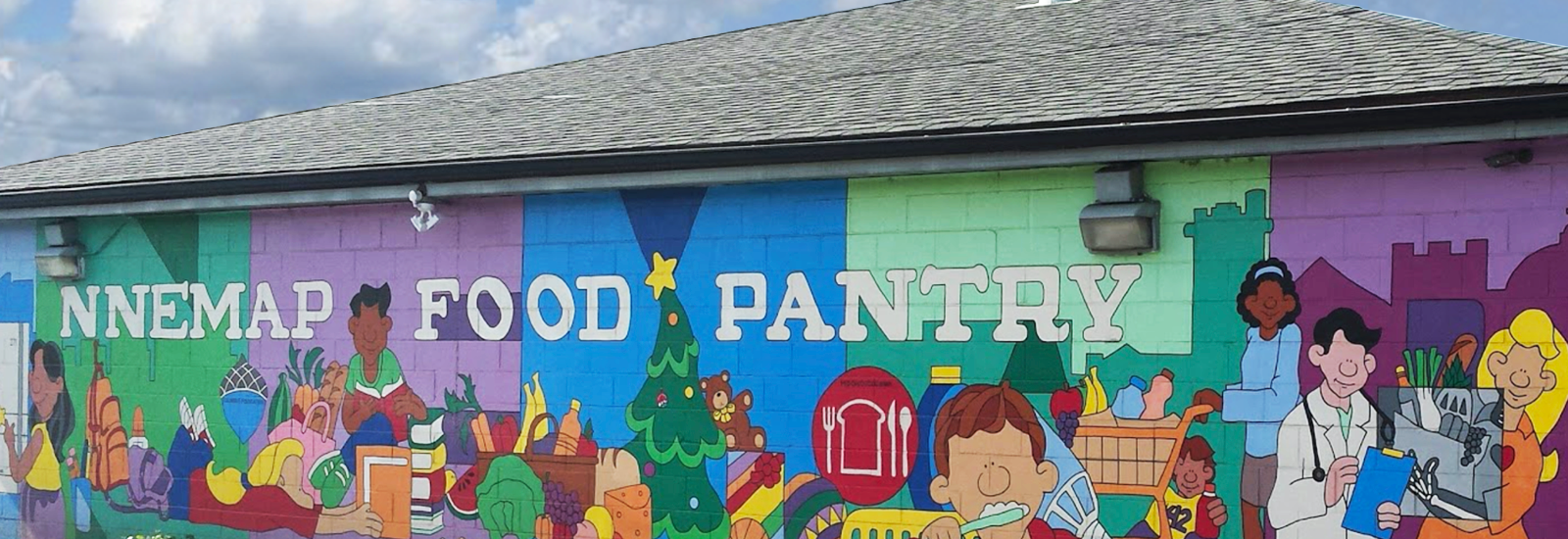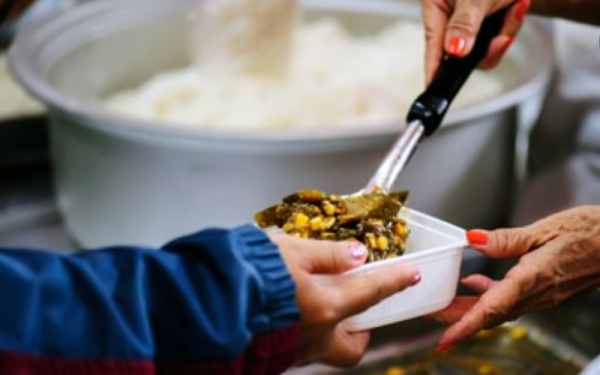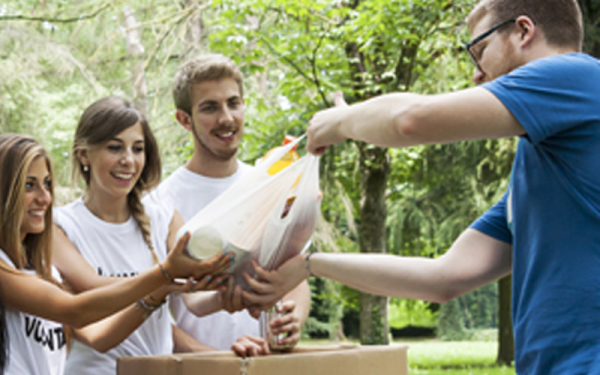
About the Author
Elizabeth Bateman (she/hers)
Elizabeth Bateman is an undergraduate fellow in the Global Arts and Humanities' 2020-21 Society of Fellows cohort. Bateman is a rising senior pursuing a major in political science and dual minors in human rights and civic engagement. She is primarily interested in environmental injustice and its impact on food access. Bateman plans to pursue a law degree after graduation in the hopes of practicing human rights law as a means to better serve those in her hometown of Villa Hills, Kentucky.
Project Overview
By conducting one-on-one interviews and volunteering weekly at a local food pantry, I have documented how NGOs, such as the Near Northside Emergency Material Assistance Program (NNEMAP) — a nonprofit social service agency distributing food and other resources to residents of Columbus, Ohio — have continued to emphasize holistic wellness rather than just focusing on mitigating hunger. With the added pressures of the COVID-19 pandemic, NNEMAP has been forced to reimagine their usual food delivery system and the ways in which they interact with their customers. My research details these unique struggles.
Introduction
At the start of this project, the principal objective was to analyze how food insecurity has been exacerbated by the COVID-19 pandemic and how the impacts have disproportionately affected racial and ethnic minorities and those of low socioeconomic status. While these original questions were confirmed, the knowledge discovered by conducting one-on-one interviews extended far beyond that. Unknowingly, a paradigm shift was developing. The primary question of my research became analyzing how food networks have gone beyond viewing food as a human right by developing systems that promote “food as medicine,” while emphasizing holistic wellness.
For one local food pantry in Columbus, Ohio, distributing fresh fruits and vegetables is of the utmost importance. Jim Hamberg, the pantry manager at NNEMAP (formerly known as the Near Northside Emergency Material Assistance Program), is aware of how many of his customers at the pantry are juggling a multitude of health issues along with putting food on the table for their families. Many of his customers experience underlying conditions such as diabetes, high blood pressure and obesity, which are oftentimes the result of a lack of proper nutrition or, at the very least, are worsened by it. Not only are these health concerns heightened by decreased access to nutritious food, but they are also underlying conditions that subsequently put their sufferers at a higher risk of dying from COVID-19, if contracted. In addition, people of color experience these conditions at a higher rate and are therefore subject to higher rates of infection, hospitalization and death from COVID-19. When compared to White or non-Hispanic persons — Black, African American, Non-Hispanic persons are at a 2.9x higher risk of being hospitalized and face a 1.9x risk of dying. Similarly, Hispanic or Latino persons are 3.1x as likely to be hospitalized and 2.3x as likely to die from the disease (CDC).
Findings
Because each state has responded differently to the COVID-19 pandemic, there have been a multitude of discrepancies in mask mandates, contact tracing, social distancing guidelines, lockdowns and maximum capacities in public places. A lack of consistency nationwide has created unnecessary burdens on local businesses, individuals and charity organizations. Similarly, NNEMAP has been forced to completely redesign their food-delivery system and adjust their methods for serving their community. Pre-pandemic, they operated with a fully-open lobby, similar to a grocery store. Customers would come into the lobby and be allowed to select their preferences themselves, receiving different quantities depending on the size of their families. For instance, this ensured that families of three were not receiving as much as families of eight in order to avoid waste and to make sure larger families were getting enough to feed their entire family.
Now, this system has changed entirely. Instead of an open lobby, customers are no longer allowed into the actual pantry and must wait outside after filling out a short information sheet to wait for their groceries. Volunteers inside the pantry pre-pack bags with a uniform number of canned goods, grains, snacks, water, poultry, produce, dairy and dessert (this list of items is not comprehensive since the stock can sometimes change but for the most part, these categories are always available). Because the volunteers are the ones now shopping for the customers with a standardized list and standardized quantity, families of different sizes are receiving the same amount. This creates potential problems with food waste and insufficient amounts for larger families. In addition, the ability to choose amongst different types of cereal, for example, is no longer possible. As a way to combat this, Pantry Manager Jim Hamberg is hoping to introduce an online ordering system. There are, of course, additional complications, such as blocking off specific days to fulfill orders and what the scheduling system and funding may look like. Online ordering is not a possibility at the moment, but in the future, it would help limit waste as folks would have more autonomy regarding food choice because Jim knows what the pantry will have in stock at the start of each week.
Another pandemic-related adjustment has been the adoption of a pantry-to-home delivery service. The introduction of this system was a way to mitigate some of the pandemic-specific concerns such as stay-at-home orders, immobility for high-risk people like the elderly and decreased access to transportation. Because many of the pantry’s visitors rely on public transportation, it has become harder to access networks like the COTA bus system in Columbus due to the risk of contracting COVID-19.
Not only is decreased accessibility a problem, but there is also the added issue of limited time to visit the pantry. As Hamberg describes it, a visit and looking for food is “a full-time job in itself." Customers “come here once a week, but that takes most of your morning, so you don’t have a whole lot of time in the rest of the day. And if you don’t have enough food, you’re going to have to go to another pantry another day.”
Childcare is the second highest requested service that folks are looking for because “when the pandemic hit, all the childcare places had to close. So, it was a scramble.” Looking for childcare while also searching for employment opportunities has made it really difficult for folks who are unemployed to get to the pantry. This is another way in which the delivery service (which will remain a permanent feature post-pandemic) has alleviated some added stressors.
When asked, Pantry Manager Jim Hamberg said he hopes the direction the pantry is moving in one of emphasizing an overarching theme of holistic wellness. With a wellness and nutrition committee dedicated to assuring NNEMAP is promoting nutritious alternatives to the slew of easy-to-access, cheap fast food restaurants crowding Columbus, Hamberg is optimistic that the pantry will be able to “break habits our customers have had for a long time” by pushing more “fresh foods and the fruits and vegetables, instead of sweets.” As discussed above, once the pantry can return to full capacity, the lobby will look a little different. Hamberg noted how “previously when [customers] went shopping, they went through everything else and got to the produce last. Now, produce is going to be the first thing they get to.” Not only will the lobby be reorganized to promote healthier choices, but Hamberg is also hoping to implement a program to allow folks to come in and get only produce any day they want.
Another program Hamberg hopes to start up is a one-stop health shop for the folks NNEMAP serves. He is very cognizant of the fact that “many of [NNEMAP’s] customers are dealing with high blood pressure, diabetes, or one or two other health conditions that food can help [with]. If they eat right, [food] can help them alleviate some of the symptoms or in essence take care of it, in cases like hypertension, for example.” Ideally, he would like to relocate the intake process so that there can be a secluded area designated for health check-ups with a registered nurse or nurse practitioner as a way to complement the new pharmacy that will be opening soon as part of the Linden Community Center.
Perhaps the number one priority for Hamberg is to get a social worker to visit the pantry on a regular basis to better support customers. Presently, NNEMAP has a supplemental form dealing with various concerns like mental health, government assistance or housing issues, but what they really need is a qualified social worker to effectively address these various needs. When the pantry first began having people fill out the form, they received around 560 requests for information, which has now been decreased to about 400 because the pantry has been successful at providing more services. The social worker would simplify this process because, as of right now, Hamberg collects the forms and processes them himself so that he can count the individual requests. He then puts in referrals to social workers over at mid-Ohio who will typically contact him or the individual who requested the service within 24 hours. Having a social worker in-house at the pantry would simplify the entire process, making it more efficient and impactful.
Another pressing concern for NNEMAP is the substantial impact that the pandemic has had on mental health. Healthcare systems of Ohio are concerned about the long-term mental crisis that could result from the pandemic. Isolation from stay-at-home orders, unemployment and other economic and social contributors have led to a sharp increase in depression, anxiety and feelings of isolation. To mitigate some of these ramifications, Hamberg and others at the pantry are trying to emphasize holistic wellness — mental health being one aspect — by bringing in social workers to provide resources for those who so desperately need them. The social workers can then refer them directly to a mental health center or to other resources to help alleviate some of the added pressures of the pandemic.
Other initiatives include a makeshift library where folks can donate and pickup books. With a library and the addition of mental health advocates, Hamberg hopes that “not only have we fed them, which is primary, but then [we have also] started to deal with some of the underlying issues that have caused them to come here in the first place.” These programs all help contribute to the overarching goal at NNEMAP of promoting holistic wellness.
- Belanger, M. J., Hill, M. A., Angelidi, A. M., Dalamaga, M., Sowers, J. R., & Mantzoros, C. S. (2020). Covid-19 and disparities in nutrition and obesity. New England Journal of Medicine, 383(11), e69.
- Béné, C. (2020). Resilience of local food systems and links to food security – A review of some important concepts in the context of COVID-19 and other shocks. Food Security, 1-18.
- Centers for Disease Control and Prevention. (2021, April 23). Risk for COVID-19 Infection, Hospitalization, and Death By Race/Ethnicity. Centers for Disease Control and Prevention.
- Devereux, S., Béné, C., & Hoddinott, J. (2020). Conceptualising COVID-19’s impacts on household food security. Food Security, 12(4), 769-772.
- Morello, P. (2021, March 12). The food bank response to COVID, by the numbers. Feeding America.
- Niles, M. T., Bertmann, F., Belarmino, E. H., Wentworth, T., Biehl, E., & Neff, R. A. (2020). The Early Food Insecurity Impacts of COVID-19. medRxiv.
- Price, R. (2015, May 1). Food pantry leaving gentrified Short North. The Columbus Dispatch.
- Schanzenbach, D. W., & A. Pitts. (2020). How much has food insecurity risen? Evidence from the Census Household Pulse Survey. Institute for Policy Research Rapid Research Report.
- TRACKING LOCAL FOOD SUPPLIES FOR HUNGRY FAMILIES. Smart Columbus OS. (n.d.).
- USDA Makes it Easier to Feed Kids and Those Who Need Food During the COVID-19 National Emergency: USDA-FNS. USDA. (n.d.).
Conclusions
My research is a testament to the ever-increasing problem that is hunger. Nearly 1.7 million people are struggling with hunger in Ohio alone. With the pandemic continuing to impact many Americans’ financial, social and health situations, there is no doubt that the increase in food insecurity will have lasting implications for the infrastructure of our food system. By volunteering each week at a local food pantry, I was able to document some of the changes that have been forced upon the system as a result of the pandemic. With adaptations such as the introduction of a home-delivery system for produce, pantries across the nation are continuing to adjust to the changing landscape of the pandemic.
I hope my research reflects the intersection of research related to food deserts as well as the unique concerns of the pandemic that have a disproportionate impact on ethnic and racial minorities, particularly those with preexisting health conditions. Some of these pressures are alleviated by organizations with a similar message to that of NNEMAP, but the burden of eradicating hunger cannot rest solely on them. Without the support of the government, the situation will continue to have dire consequences for millions of Americans.



